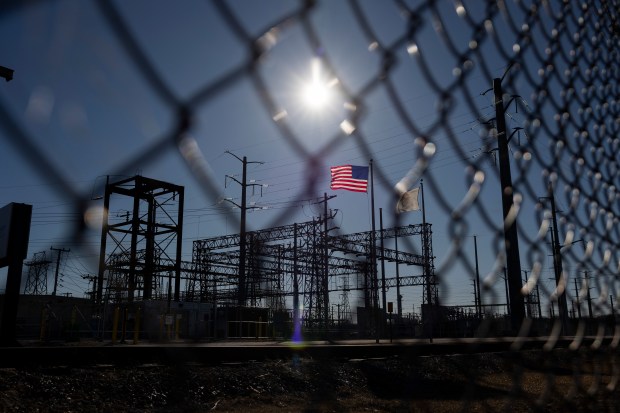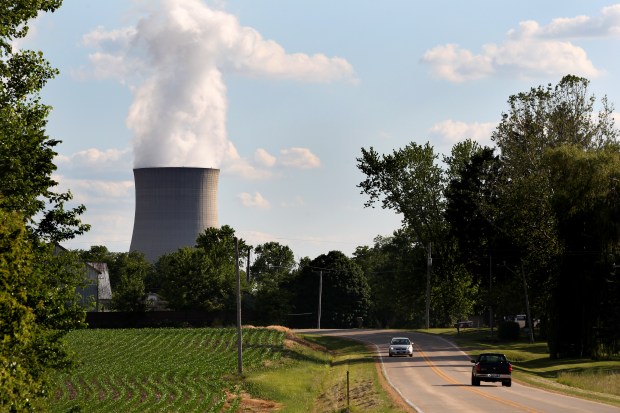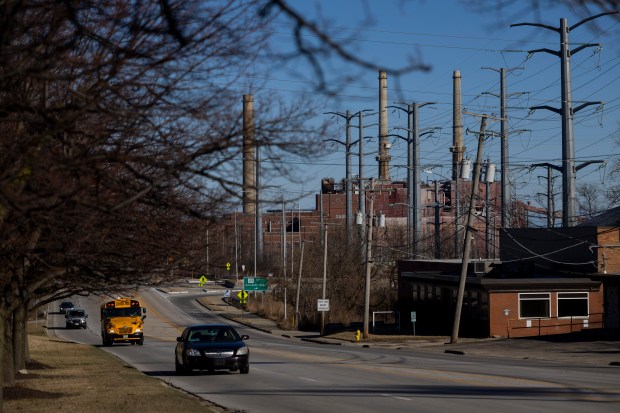Hydrogen, the most abundant element on earth, could be key to fighting climate change, but only if private companies, local communities and the federal government can agree on how to regulate it.
The stakes are high. Without a robust infrastructure to produce and deploy hydrogen energy, the U.S. will lose out on a crucial clean energy source. However, bringing this infrastructure to scale may be fraught with unintended consequences like skyrocketing consumer electricity prices, worsening air pollution and even more greenhouse gas emissions.
The Biden administration has touted hydrogen energy as essential to achieving net-zero emissions nationally by 2050 and made a historic $7 billion dollar investment to build seven regional clean hydrogen hubs across the country, including a Midwest hub.
The Midwest Alliance for Clean Hydrogen (MachH2), a partnership of over 70 private and public entities, has been awarded up to $1 billion of these federal funds to create the hub, which will span Illinois, Indiana and Michigan.
The alliance anticipates reducing carbon emissions by approximately 3.9 million metric tons per year — equivalent to taking over 867,000 gasoline-powered cars off the road annually — by supplying hydrogen energy to steelmaking, glass production, refining, trucking and aviation. These heavy-duty industries, which are largely concentrated in the Midwest, represent nearly one-third of national emissions and have struggled to find sufficient clean energy sources.
Hydrogen energy is a promising option because it is an extremely efficient and versatile fuel source like coal and natural gas. But, unlike those fossil fuels, it can be created without emitting greenhouse gases.
“(Hydrogen) will be critical to decarbonize that last 10% to 20% of industry because we don’t have sufficient biofuels and (electric) batteries are limited to certain applications,” said Iryna Zenyuk, the director of the National Fuel Cell Research Center, who has no affiliation to the hubs. “We cannot decarbonize without it.”
MachH2 put forward plans for nine hydrogen production and distribution projects but has declined to give specifics or provide opportunity for community input until it finishes negotiating its award with the U.S. Department of Energy, a process that is expected to take several months. This has left many local communities and environmentalists skeptical, especially as MachH2 also attempts to weaken federal regulations on hydrogen energy production.
History raises skepticism
The intertwining legacies of industry, pollution and disenfranchisement linger in the Rust Belt towns where MachH2 promises to boost local economies and clean up the energy supply.
Take Frank Pettis, for example. His grandparents were sharecroppers in the Mississippi River Delta who migrated to Waukegan during the last wave of the Great Migration. They were drawn by jobs at manufacturing facilities and processing plants that are now superfund sites: an EPA designation for the nation’s most contaminated land.
Today, Pettis is a community organizer at Clean Power Lake County, a nonprofit dedicated to safeguarding air, land and water in the Waukegan area after decades of industrial pollution. The same companies that provided his family with jobs also harmed their health, he said, citing high prevalences of asthma and rare cancers in his community.
Hydrogen energy has the potential to clean the air in communities like Waukegan and replace dirty industry jobs with clean energy jobs. But it is not a given that hydrogen energy will be clean. According to the Energy Department, 95% of the hydrogen in the U.S. is produced via an emissions-intensive process reliant on fossil fuels.
MachH2, however, says the hydrogen production facilities it plans to build will use emissions-free electricity — like nuclear, wind and solar power — to split water into hydrogen and oxygen: a process called electrolysis. The resulting hydrogen can be used for energy, and the oxygen can be harmlessly released into the atmosphere. No greenhouse gases are emitted.
But environmental justice activists like Pettis worry that MachH2’s processes won’t be as clean as the alliance claims.
“In the Black community and in the Latino community, we are well acquainted with these buzzword projects like hydrogen that are supposedly the next big thing but are really just a continuation of systems of harm,” Pettis said.
High-profile billion-dollar private-public energy projects promising to clean Illinois’ energy supply do not have a reassuring track record.
FutureGen, a carbon capture and sequestration project at a coal-fired electric power plant in Meredosia, a village in western Illinois, was originally bolstered by $1 billion in federal funding. But the funds were withdrawn and the project was indefinitely suspended following accusations that it would raise electricity prices for Illinoisans.

Debate over lucrative tax credit
At the national level, a debate is playing out to determine when electrolysis is eligible for a lucrative federal tax credit that could exceed $70 billion over the next decade, according to energy research group BloombergNEF. These subsidies are on top of the $7 billion dedicated to building out the regional hubs.
The U.S. Department of the Treasury proposed eligibility criteria for the hydrogen production tax credit in December. These rules have been applauded by many environmentalists but opposed by MachH2 and the leaders of the six other regional hubs.
One criterion requires hydrogen producers to source emissions-free electricity from power plants that came into operation no more than three years before the hydrogen production facility opened.
“Otherwise, even if you claim to be using zero carbon energy — for instance from an existing wind turbine or an existing nuclear plant — all that happens is a bit of resource shuffling,” said Pete Budden, a hydrogen advocate with the Natural Resource Defense Council. “To meet the extra load that you’ve added to the grid — because the homes and businesses that were previously using that existing zero-carbon energy still need energy — (another power source) has to increase, and that will be fossil fuels (because) they’re the thing that usually gets turned up when there’s an extra load on the grid.”
In this scenario, emissions would increase, communities near fossil fuel generators would face even more air pollution and electricity prices would spike since the increase in demand isn’t being balanced by an increase in supply, according to a letter sent to MachH2 leadership by 47 environmental groups, including the Natural Resource Defense Council and Pettis’ Clean Power Lake County.
The proposed rules also require the clean electricity to be procured from a nearby power plant within the same hour it is used to produce hydrogen.
These criteria aim to ensure hydrogen isn’t being produced when clean energy is not readily available. Otherwise, producers could use fossil fuel-based electricity but offset it by purchasing an equal amount of clean energy produced anywhere in the country at a later date, Budden said.
Innovation and flexibility
In a joint letter to the Treasury Department in late February, MachH2 and the leadership of the six other hubs said that, if the tax credit eligibility requirements are implemented as written, many of their projects “will no longer be economically viable.”
Several MachH2 alliance partners, including energy giants BP and Constellation Energy, have individually come out against aspects of the rules, too.
The draft requirements would force the Midwest hub to cancel its nuclear hydrogen production project with Constellation, said MachH2 CEO Dorothy Davidson in a separate letter to the Treasury Department.
Davidson asked the Treasury Department to allow hydrogen producers to secure up to 10% of their electricity from clean sources more than three years older than their facility, calling it a “reasonable and conservative” revision that would enable existing nuclear plants to participate in the hub.

Electricity plants and hydrogen producers need flexibility to experiment and calibrate, said Jennifer Dunn, MachH2’s chief decarbonization officer and a Northwestern University engineering professor.
“I think of the hydrogen economy as an orchestra warming up. Everybody’s playing notes that don’t come together and are messy. But you had to go through that process to get to the concert,” Dunn said. “And to me, that messy part is what we’re in now.”
Different models predict varying impacts of hydrogen energy production on emissions, and reality can only be confirmed once hydrogen energy projects are deployed. After the industry is given some runway to grow, precise adjustments can be made to steer hydrogen production in the cleanest direction possible, Dunn said.
“If we make it too hard for hydrogen to take off, we take it out of our toolbox to address climate change,” she said.
The hubs and politicians also worry that hindering hydrogen energy projects before they start could cause the U.S. to forgo its competitive edge on the burgeoning industry.
The European Union has similar regulations to those the Treasury Department proposed, but it’s phasing them in over a longer period. In a similar vein, MachH2 proposed a slower phase-in for the requirement that producers secure electricity in the same hour they use it.
Meanwhile on Capitol Hill, some lawmakers are questioning whether the rules align with the intentions of the Inflation Reduction Act, which authorized the hubs and tax credit.
Illinois Sens. Dick Durbin and Tammy Duckworth and Michigan Sen. Gary Peters, who all voted in support of the act, co-signed a letter to the Treasury Department cautioning against the proposed requirements.
“Illinois is ready to lead the nation in (clean hydrogen) production, but our state could lose out if this tax credit excludes our fleet of existing clean energy resources from qualifying. I’m working to ensure that doesn’t happen,” Durbin said in a statement to the Tribune in early March.
In his own letter to the Treasury Department in late February, Illinois Gov. J.B. Pritzker also urged for “clear, workable circumstances under which existing zero-emission generators can receive the 45V tax credit in the final rule, such that the MachH2 hub remains economically viable.”
Rethinking projects
While it may be tempting to reduce this to another battle between industry and environmentalists, many major companies involved in hydrogen production actually endorse the draft tax credit eligibility criteria.
“It’s bad industry actors versus industry groups with the foresight and the long-term thinking to recognize these are the rules we need for the long-term success of the industry,” said Budden, the NRDC hydrogen advocate.
Seven companies, including a leading merchant seller of hydrogen and one of the largest electrolyzer manufacturers in the country, sent a letter to the Treasury Department and White House saying they are already developing and deploying large-scale clean hydrogen projects that comply with the proposed rules.
So, it might not be a bad thing if the Treasury Department’s guidance makes the hubs rethink their projects, suggested Budden.
“We don’t want to allow the hubs to dictate policy for the whole, potentially hundreds of billions of dollars program of this 45V tax credit. This would be getting things the wrong way around,” he said. “We should design rules that make sense on an emissions basis, protect electricity consumers and protect progress on decarbonizing the grid for the tax credit, and then implement hubs that can meet those rules.”
Calls for community engagement

The Treasury Department is expected to finalize the tax credit eligibility requirements later this year. Until then, the viability of MachH2’s projects adds to the list of questions community groups have had about the alliance for months.
MachH2 has deferred sharing specifics or engaging with community stakeholders until it finalizes its award negotiations with the Energy Department.
Well before MachH2 was selected in October to create the Midwest hub, Indiana-based organizers sent the Energy Department a letter expressing dismay that they were “shut out” from the grant application process as submissions were being reviewed in June.
However, MachH2 Equity Justice Officer Elizabeth Kocs assured that “individuals and organizations have not missed out on MachH2 engagement opportunities.”
There will be advisory committees and councils made up of regional leaders, in-person and virtual town halls, and an online dashboard to collect input and report progress, said Kocs, who also serves as a senior manager at GTI Energy, an Illinois-based energy technology development organization and alliance member.
Nevertheless, environmental justice activists like Pettis worry that decisions affecting emissions, air quality and household electricity prices may already be finalized by the time community members get a seat at the table.
“Are they willing to incorporate the ideals of the community into their planning? Are they willing to increase transparency around these projects? Or are we going to be given a platform after the decisions have already been made behind closed doors?” Pettis said.
MachH2 has the potential to dramatically reduce emissions, increase jobs and restore public confidence in public-private clean energy projects in the Midwest. Conversely, it could perpetuate a legacy of skepticism of well-funded projects with lofty intentions and murky plans.




